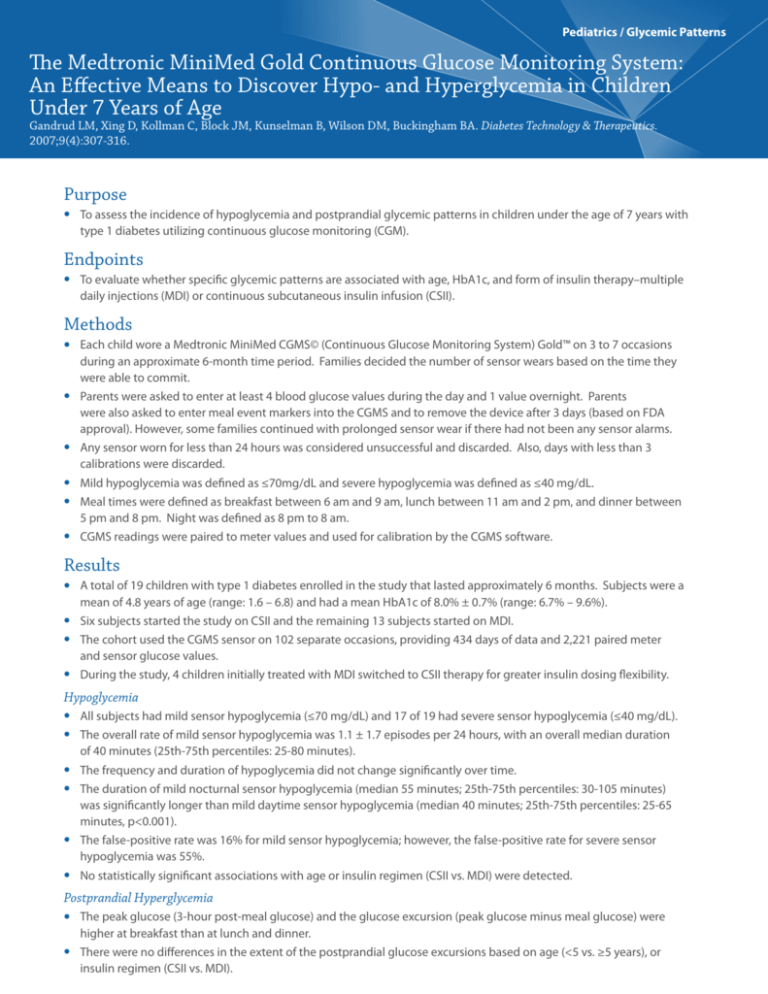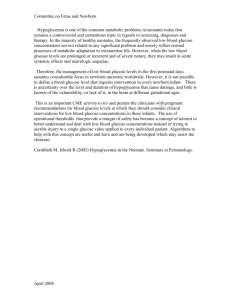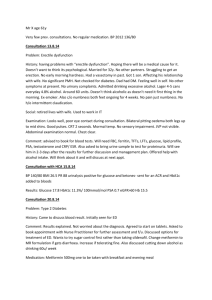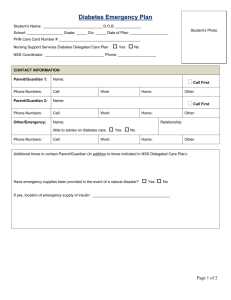
Pediatrics / Glycemic Patterns
The Medtronic MiniMed Gold Continuous Glucose Monitoring System:
An Effective Means to Discover Hypo- and Hyperglycemia in Children
Under 7 Years of Age
Gandrud LM, Xing D, Kollman C, Block JM, Kunselman B, Wilson DM, Buckingham BA. Diabetes Technology & Therapeutics.
2007;9(4):307-316.
Purpose
•
T o assess the incidence of hypoglycemia and postprandial glycemic patterns in children under the age of 7 years with
type 1 diabetes utilizing continuous glucose monitoring (CGM).
Endpoints
•
To evaluate whether specific glycemic patterns are associated with age, HbA1c, and form of insulin therapy–multiple daily injections (MDI) or continuous subcutaneous insulin infusion (CSII).
Methods
•
•
•
•
•
•
Each child wore a Medtronic MiniMed CGMS© (Continuous Glucose Monitoring System) Gold™ on 3 to 7 occasions
during an approximate 6-month time period. Families decided the number of sensor wears based on the time they were able to commit.
Parents were asked to enter at least 4 blood glucose values during the day and 1 value overnight. Parents
were also asked to enter meal event markers into the CGMS and to remove the device after 3 days (based on FDA approval). However, some families continued with prolonged sensor wear if there had not been any sensor alarms.
Any sensor worn for less than 24 hours was considered unsuccessful and discarded. Also, days with less than 3
calibrations were discarded.
Mild hypoglycemia was defined as ≤70mg/dL and severe hypoglycemia was defined as ≤40 mg/dL.
Meal times were defined as breakfast between 6 am and 9 am, lunch between 11 am and 2 pm, and dinner between
5 pm and 8 pm. Night was defined as 8 pm to 8 am.
CGMS readings were paired to meter values and used for calibration by the CGMS software.
Results
•
A total of 19 children with type 1 diabetes enrolled in the study that lasted approximately 6 months. Subjects were a
mean of 4.8 years of age (range: 1.6 – 6.8) and had a mean HbA1c of 8.0% ± 0.7% (range: 6.7% – 9.6%).
Six subjects started the study on CSII and the remaining 13 subjects started on MDI.
The cohort used the CGMS sensor on 102 separate occasions, providing 434 days of data and 2,221 paired meter
and sensor glucose values.
•
•
•
During the study, 4 children initially treated with MDI switched to CSII therapy for greater insulin dosing flexibility.
Hypoglycemia
•
•
•
•
•
•
All subjects had mild sensor hypoglycemia (≤70 mg/dL) and 17 of 19 had severe sensor hypoglycemia (≤40 mg/dL).
The overall rate of mild sensor hypoglycemia was 1.1 ± 1.7 episodes per 24 hours, with an overall median duration
of 40 minutes (25th-75th percentiles: 25-80 minutes).
The frequency and duration of hypoglycemia did not change significantly over time.
The duration of mild nocturnal sensor hypoglycemia (median 55 minutes; 25th-75th percentiles: 30-105 minutes)
was significantly longer than mild daytime sensor hypoglycemia (median 40 minutes; 25th-75th percentiles: 25-65
minutes, p<0.001).
The false-positive rate was 16% for mild sensor hypoglycemia; however, the false-positive rate for severe sensor
hypoglycemia was 55%.
No statistically significant associations with age or insulin regimen (CSII vs. MDI) were detected.
Postprandial Hyperglycemia
•
The peak glucose (3-hour post-meal glucose) and the glucose excursion (peak glucose minus meal glucose) were
higher at breakfast than at lunch and dinner.
There were no differences in the extent of the postprandial glucose excursions based on age (<5 vs. ≥5 years), or
insulin regimen (CSII vs. MDI).
•
•
Children with HbA1c values ≥8.0% had higher mean postprandial glucose values after breakfast and lunch when compared to children with HbA1c values <8.0%.
Children with HbA1c values >8.0% had peak post-breakfast sensor glucose values that reached, and likely exceeded, 400 mg/dL more frequently than did children with HbA1c values <8.0% (27 vs. 7, p<0.001). This also occurred after lunch and dinner and caused the peak post-prandial glucose values to be underestimated to a greater extent in children with HbA1c values >8.0%.
There was no association between the presence of preceding nocturnal hypoglycemia and post-breakfast peak
glucose values.
•
•
Meal Results Summary*
p value
Breakfast
(n=182) (n=211) Lunch Dinner (n=231) Breakfast vs. lunch Breakfast Lunch vs.
vs. dinner dinner
3-hour post-meal mean glucosea
247 ± 64
199 ± 67
194 ± 63
<0.001
<0.001
0.60
3-hour post-meal peak glucosea
313 ± 66
252 ± 78
257 ± 75
<0.001
<0.001
0.65
Data are mean ± SD values as indicated. SD represents within-subject variation. Glucose concentrations are in mg/dL.
a
The post-meal mean and peak glucose values are underestimated as there were 66 meals where the peak value was 400 mg/dL (34 at breakfast, 18 at lunch, 14 at dinner).
Rate of Glucose Change After Meals
•
•
The most rapid rate of rise occurred 15-30 minutes after the parental-entered meal marker.
Rates of change did not differ significantly based on HbA1c levels.
•
Neither HbA1c levels nor the mean sensor glucose changed meaningfully over time. The mean HbA1c value at the start of study was 8.0 ± 0.7% (n=19) compared to 8.0 ± 0.5% (n=17) at the last visit.
The mean sensor glucose and the percentage of time with sensor glucose >200 mg/dL were significantly
associated with HbA1c (p<0.001 for both).
The percentage of time with sensor glucose ≤70, ≤60, or ≤50 mg/dL was not significantly associated with HbA1c values.
•
•
Adverse Events
•
•
•
There were no serious adverse events.
Families occasionally reported mild irritation and rash at the insertion site; no child required therapy.
Over 50% of the sensors were worn for greater than 72 hours and no infections occurred, despite prolonged use.
Conclusions
•
•
The CGMS was well tolerated by young children with diabetes.
The near-continuous device detected more episodes of both mild and severe hypoglycemia than did home blood
glucose monitoring, although the sensor false-positive rate was high for severe hypoglycemia.
Postprandial hyperglycemia associated with a rapid rate of change in glucose was found to be the most marked
after breakfast.
Subjects with higher postprandial glucose levels were associated with higher HbA1c levels.
•
•
*Adapted from study.
9501239-011 090909 ©Medtronic MiniMed, Inc. 2009. All rights reserved.
Gandrud LM, Xing D, Kollman C, Block JM, Kunselman B, Wilson DM, Buckingham BA. “The Medtronic MiniMed Gold Continuous Glucose Monitoring System:
An Effective Means to Discover Hypo- and Hyperglycemia in Children Under 7 Years of Age.” Diabetes Technology & Therapeutics. 2007;9(4):307-316.
HbA1c and Mean Sensor Glucose Levels






